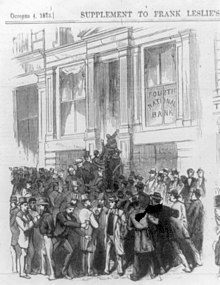
Back ذعر عام 1873 Arabic Osnivački krah 1873. BS Pànic de 1873 Catalan Krach na vídeňské burze Czech Økonomiske krise i 1873 Danish Gründerkrach German Paniko de 1873 EO Pánico de 1873 Spanish 1873ko Izua EU Crise bancaire de mai 1873 French

The Panic of 1873 was a financial crisis that triggered an economic depression in Europe and North America that lasted from 1873 to 1877 or 1879 in France and in Britain. In Britain, the Panic started two decades of stagnation known as the "Long Depression" that weakened the country's economic leadership.[1] In the United States, the Panic was known as the "Great Depression" until the events of 1929 and the early 1930s set a new standard.[2]
The Panic of 1873 and the subsequent depression had several underlying causes for which economic historians debate the relative importance. American inflation, rampant speculative investments (overwhelmingly in railroads), the demonetization of silver in Germany and the United States, ripples from economic dislocation in Europe resulting from the Franco-Prussian War (1870–1871), and major property losses in the Great Chicago Fire (1871) and the Great Boston Fire (1872) helped to place massive strain on bank reserves, which, in New York City, plummeted from $50 million to $17 million between September and October 1873.
The first symptoms of the crisis were financial failures in Vienna, the capital of Austria-Hungary, which spread to most of Europe and to North America by 1873.
- ^ Cite error: The named reference
Mussonwas invoked but never defined (see the help page). - ^ "What history teaches us about the welfare state". The Washington Post. 29 August 2011. Retrieved 10 September 2011.